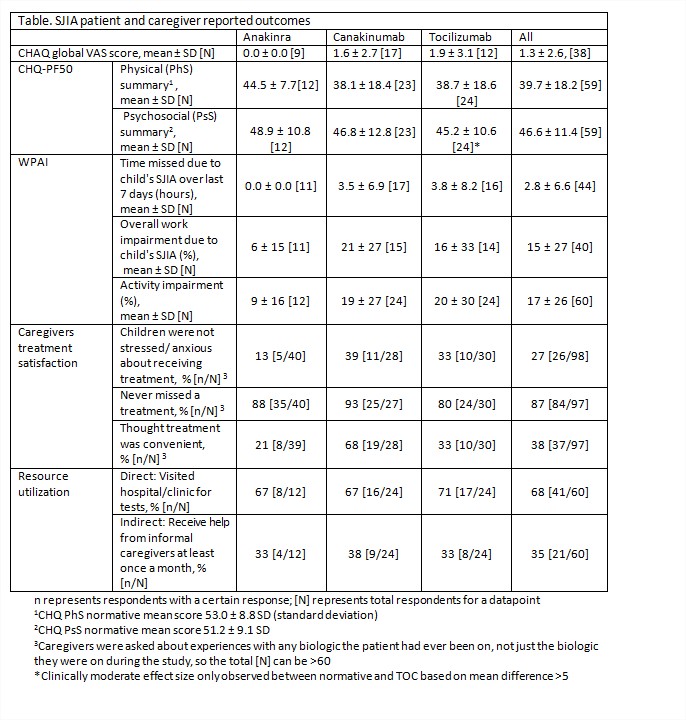Session Information
Session Type: ACR Poster Session C
Session Time: 9:00AM-11:00AM
Background/Purpose: Systemic juvenile idiopathic arthritis (SJIA) is a severe autoinflammatory disease characterized by systemic features including high fevers, rash, and arthritis. SJIA can impose a high physical, psychosocial, behavioral and financial burden on patients and their families. This international, real-world study conducts a detailed analysis of the impact of the burden of SJIA by evaluating caregiver perspectives of disease burden utilizing a SJIA-specific questionnaire combined with physician data about disease severity and treatment.
Methods: SJIA treatment centers in France, Germany, Netherlands, UK and the US participated. Patients were 4-18 years with confirmed SJIA and received one of the following biologic treatments for ≥2 months: anakinra (ANA), canakinumab (CAN), or tocilizumab (TOC). Caregivers had cared for the patients for the previous ≥6 months, were >18 years, spent ≥50% of their time with the patients, and completed a SJIA-specific survey. Physicians reported disease severity and treatment through retrospective chart review. Ethics committee approvals and written informed consent were obtained. The caregiver questionnaire assessed the impact of SJIA on the practical, social and emotional aspects of caregivers’ lives. Validated and tailored patient-reported outcome (PRO) measures were used: the Child Health Questionnaire-Parent Form 50 (CHQ-PF50), 36-Item Short Form Health Survey (SF-36), and Work Productivity and Activity Impairment Questionnaire: Specific Health Problem (WPAI:SHP). Tailored questions collected data on patient function, treatment satisfaction and direct/indirect resource utilization.
Results: Sixty patients enrolled from 6/15-5/16: 12 on ANA, 24 on CAN, 24 on TOC; 45% from the US; 47% female; mean age at survey was 11.3 years. Mean age at SJIA diagnosis was 6.7 years, mean age at start of ANA, CAN, and TOC Rx was 7.4, 8.9, and 6.7 years, respectively. Caregivers were 80% female, mean age 41.4 years, and 37% reduced or stopped working due to their child’s SJIA. Of the patients enrolled on CAN and TOC, 71% and 46% respectively had previously been on ANA. Baseline CHAQ, CHQ-PF50, and WPAI scores were worse in CAN and TOC than ANA patients (Table). Highest caregiver stressors were worry over long-term SJIA impact on their child (44%) and uncertainty about the future (29%). Caregivers’ treatment satisfaction and resource utilization varied (Table). Conclusion: Treatment sequencing and PRO measures indicate ANA is used as 1st line for mild SJIA while CAN and TOC are used as 2nd/3rd line for severe SJIA. Caregivers expressed stress over the long-term impact of SJIA and fear for the future and had variable treatment satisfaction and resource utilization levels.
To cite this abstract in AMA style:
Shenoi S, Horneff G, Cidon M, Ramanan A, Kimura Y, Quartier P, Foeldvari I, Zeft A, Lomax KG, Gregson J, Campbell S, Weiss J, Marinsek N, Patel D, Wulffraat N. The Disease Burden of Systemic Juvenile Idiopathic Arthritis for Patients and Caregivers: An International Health Related Quality of Life Survey and Retrospective Chart Review [abstract]. Arthritis Rheumatol. 2016; 68 (suppl 10). https://acrabstracts.org/abstract/the-disease-burden-of-systemic-juvenile-idiopathic-arthritis-for-patients-and-caregivers-an-international-health-related-quality-of-life-survey-and-retrospective-chart-review/. Accessed .« Back to 2016 ACR/ARHP Annual Meeting
ACR Meeting Abstracts - https://acrabstracts.org/abstract/the-disease-burden-of-systemic-juvenile-idiopathic-arthritis-for-patients-and-caregivers-an-international-health-related-quality-of-life-survey-and-retrospective-chart-review/

